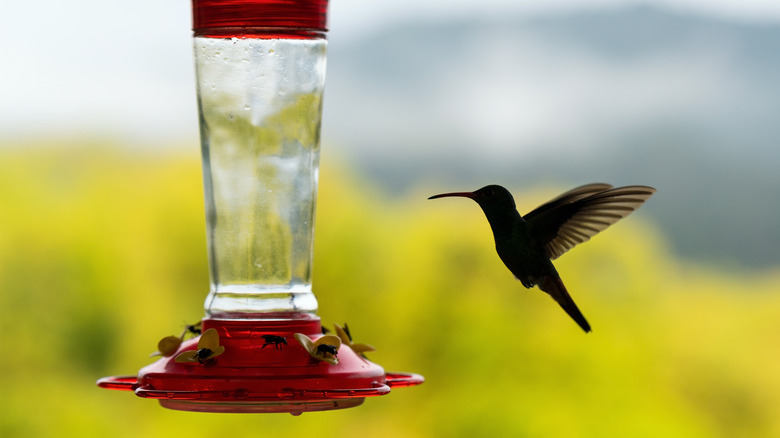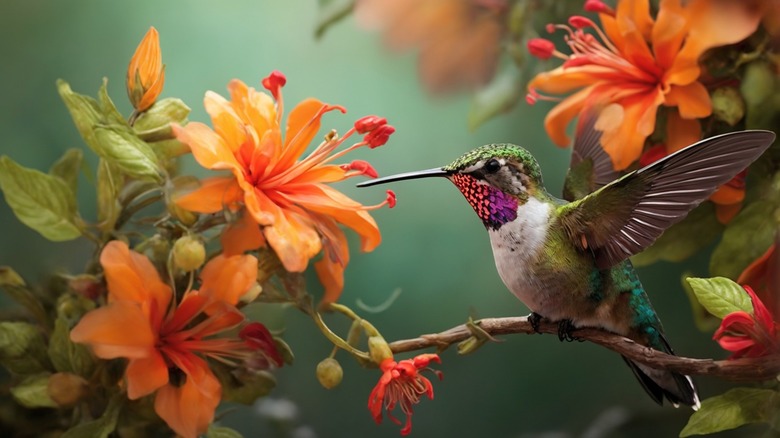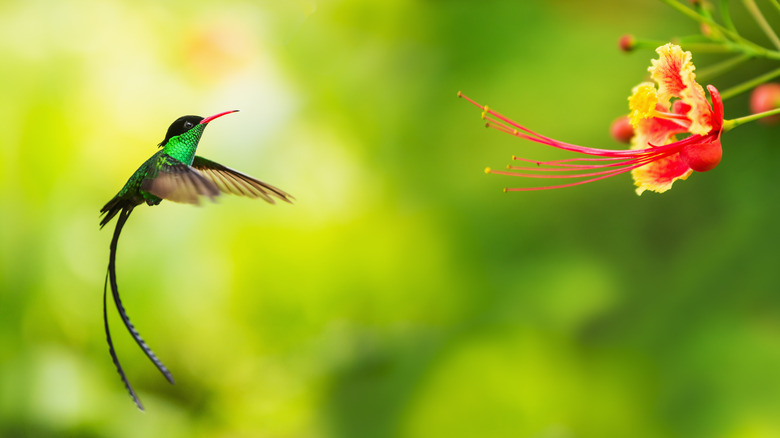If Your Hummingbird Feeder Gets Low Quickly, This Could Be Why
Do you keep finding that your hummingbird feeder is always low on nectar? You may be rightly surprised how the precious liquid disappears so quickly after you refill it. Perhaps you've even checked whether the contraption is leaking the nectar out or allowing it to evaporate. We'll set your mind at ease. The quickly depleting nectar levels are a perfectly normal sight if hummingbirds frequent your property. Hummingbirds are voracious feeders with a surprisingly robust appetite, so while you wouldn't expect them to empty the feeder in just a few days' time, that's exactly what these birds are built to do.
Hummingbirds are on a quest for food for most of their waking hours. This never-ending urge to eat shouldn't come as a surprise given their energy-draining lifestyle and bodily functions. Just imagine how many calories these tiny creatures must burn to flap their wings up to 200 times per second, hit speeds of over 40 miles per hour, and achieve a heart rate of over 1,000 beats per minute during flight. Replenishing the energy stores with sugary nectar — and other yummy, nutritious treats — is an all-consuming affair for these birds. Below, we explain just how much food hummingbirds need to stay alive and keep moving, and give you a few tips for keeping their stomachs full.
Hummingbirds' impressive appetite explained
Hummingbirds' gargantuan appetite stems from their high metabolism. Having a high metabolism means that an organism needs to consume a great deal of calories to avoid losing weight. With hummingbirds, though, the need for calories surpasses mere weight maintenance — if they don't consume enough food to replenish their ever-depleting energy stores, they may simply not survive. To meet their lofty nutrition requirements, hummingbirds eat half their body weight worth of sugar every single day. They accomplish this impressive feat by feeding as often as six times every hour — that's 72 meals in just half a day!
Now, eating every ten minutes is demanding not just in terms of the energy spent on consuming nectar. These voracious feeders are constantly searching for sources of nutrition, and their quest takes anywhere between 1,000 and 2,000 flowers daily. Aiding them in this mission is their small but remarkably advanced brain, which is calibrated to remember the location of previous meals. Meanwhile, hummingbirds' long tongues do the hard work of scooping nectar out of flowers, making 13 licks every second. But nectar is not the sole source of calories for hummingbirds. While these birds definitely have a love affair with sugar, they don't pass up the more savory, protein-rich meals offered by small insects, such as fruit flies. Incredibly, hummingbirds can prey on bees and wasps, too. The birds' enviable eyesight helps them track down insects when they're not busy drinking nectar from flowers.
How to keep hummingbirds' tummies full
Now that you understand why the hummingbird feeder outside your home empties so quickly, you can plan ways to keep your feathered friends' food from running low. As a rule of thumb, you should clean and refill the feeder at least every other day when the weather is hot, and on a weekly basis when it's cold out. This frequency is important for warding off mold growth. However, if you notice that these refills are not keeping up with the hummingbirds' appetites, then of course, you should clean and refill the feeder with new nectar more often. There are lots of homemade hummingbird nectar recipes that are surprisingly easy to make.
You don't have to rely on homemade nectar alone to keep the hummingbirds' appetites satisfied. Growing certain flowering plants will invite hummingbirds to your yard and help you keep their tummies full. Plants that are most appealing to hummingbirds are those with sugary nectar that's liquid enough for the birds to drink. These plants' blooms are generally elongated and downward-facing, and the inflorescence has a bright color that catches the birds' attention. Trumpet creeper, bee balm, bleeding heart, foxglove, azaleas, coral honeysuckle, and columbine are all flowers that hummingbirds will absolutely love to feast on if you grow them on your property. To treat your visiting birds to a natural buffet from spring until fall, plant a large variety of these hummingbird favorites, being sure to include flowers that bloom during different seasons.


